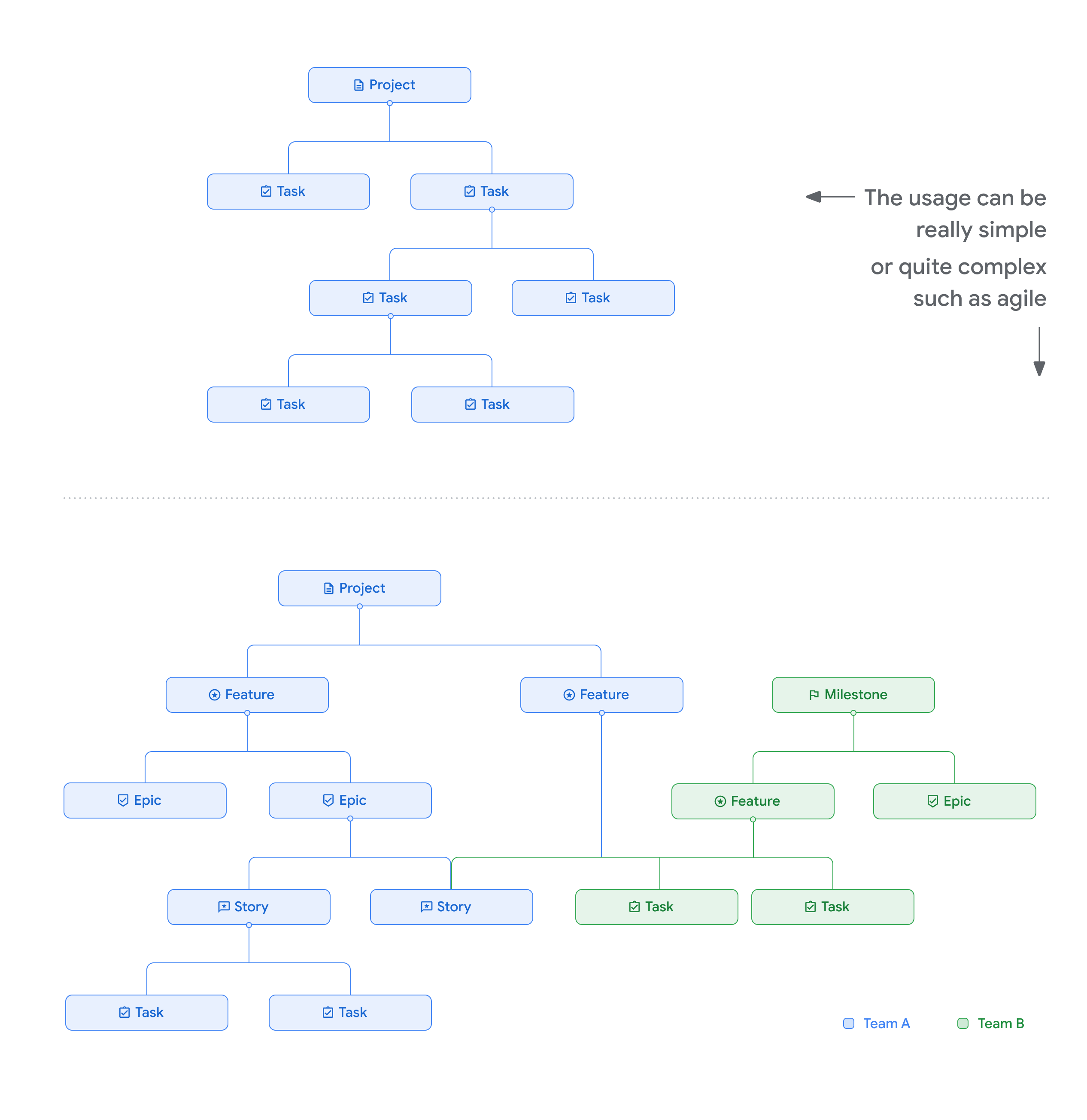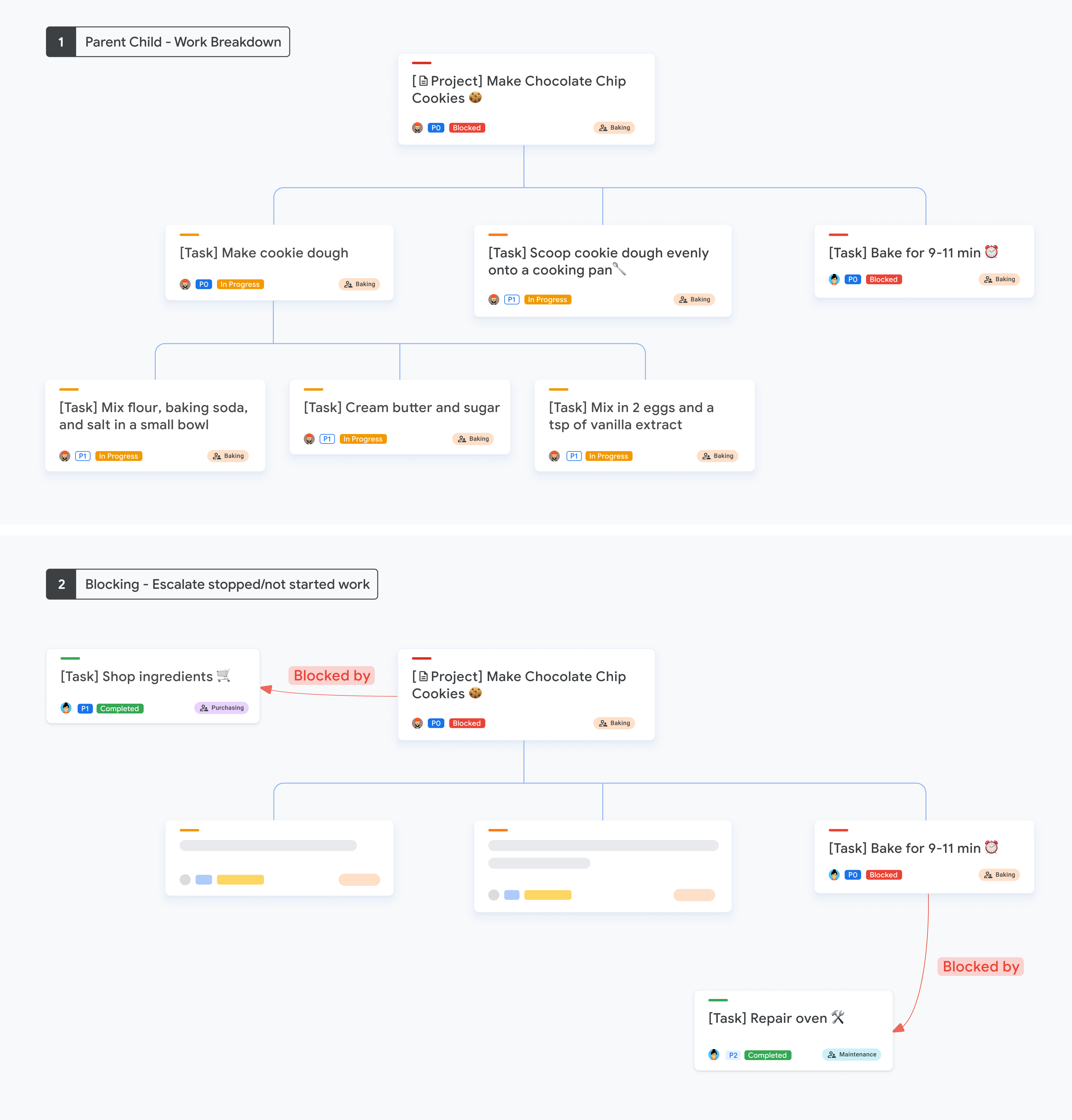পিতা-মাতা-সন্তানের সম্পর্ক
সেভ করা পৃষ্ঠা গুছিয়ে রাখতে 'সংগ্রহ' ব্যবহার করুন
আপনার পছন্দ অনুযায়ী কন্টেন্ট সেভ করুন ও সঠিক বিভাগে রাখুন।
Google ইস্যু ট্র্যাকার পিতামাতা-সন্তান সম্পর্ক সমর্থন করে। একটি অভিভাবক-সন্তান সম্পর্ক সাধারণত একটি প্রদত্ত প্রচেষ্টার মধ্যে কাজের ভাঙ্গনের প্রতিনিধিত্ব করতে ব্যবহৃত হয়। একজন পিতামাতার একাধিক সন্তান থাকতে পারে এবং একটি সন্তানের একাধিক পিতামাতা থাকতে পারে।
পিতামাতা-সন্তানের সম্পর্কের নিম্নলিখিত বৈশিষ্ট্য রয়েছে:
| চারিত্রিক | বিস্তারিত |
|---|
| সম্পর্ক | N:N |
| অর্ডার দিচ্ছে | একটি পিতামাতার মধ্যে শিশুদের আদেশ সমর্থিত. |
| চক্র সনাক্তকরণ | চক্র নির্ভরতা সিস্টেম দ্বারা প্রতিরোধ করা হয়. |
| সর্বোচ্চ সরাসরি শিশুদের | 500 |
| সর্বোচ্চ পূর্বপুরুষ | 1000 |
উদাহরণ
নিম্নলিখিত গ্রাফিক কিছু নমুনা পিতামাতা-সন্তান সম্পর্কের দেখায়।

পিতামাতা-সন্তানের সম্পর্ক এবং ব্লকিং
আপনি যখন পিতা-মাতা-সন্তানের সম্পর্ক ব্যবহার করেন তখন বিদ্যমান ব্লক করা এবং সম্পর্কের দ্বারা ব্লক করা এখনও সমর্থিত। আপনি যখন অভিভাবক-সন্তানের সম্পর্ককে ব্লক করার সাথে একত্রিত করছেন:
- কাজকে ছোট ইউনিটে বিভক্ত করতে পিতামাতা-সন্তানের সম্পর্ক ব্যবহার করুন।
- যখন সময় এবং ক্রম গুরুত্বপূর্ণ হয় তখন ব্লক করা এবং অবরুদ্ধ করা ব্যবহার করুন এবং আপনি UI-তে স্পষ্ট ইঙ্গিত দিতে চান যাতে কাজ বন্ধ বা শুরু না হয়।
নিম্নলিখিত গ্রাফিক পিতামাতা-সন্তান এবং ব্লকিং কাজের ব্রেকডাউনের উদাহরণ দেখায়।

সর্বস্বত্ব সংরক্ষিত। Java হল Oracle এবং/অথবা তার অ্যাফিলিয়েট সংস্থার রেজিস্টার্ড ট্রেডমার্ক।
2025-07-24 UTC-তে শেষবার আপডেট করা হয়েছে।
[null,null,["2025-07-24 UTC-তে শেষবার আপডেট করা হয়েছে।"],[[["\u003cp\u003eGoogle Issue Tracker enables the creation of parent-child relationships to represent the hierarchical breakdown of work within a project.\u003c/p\u003e\n"],["\u003cp\u003eIssues can have multiple parents and children, but the system prevents circular dependencies and limits the number of direct children to 500 and total ancestors to 1000.\u003c/p\u003e\n"],["\u003cp\u003eWhile parent-child relationships are ideal for structuring tasks, "Blocking" and "Blocked by" relationships should be used to indicate critical timing and sequencing dependencies.\u003c/p\u003e\n"],["\u003cp\u003eUsers are encouraged to leverage both relationship types to manage work effectively, using parent-child for work breakdown and blocking for highlighting time-sensitive dependencies.\u003c/p\u003e\n"]]],[],null,["# Parent-Child Relationships\n\nGoogle Issue Tracker supports parent-child relationships. A parent-child\nrelationship is typically used to represent the breakdown of work within a given\neffort. A parent can have multiple children, and a child can have multiple\nparents.\n\nThe parent-child relationship has the following characteristics:\n\n| Characteristic | Details |\n|-------------------------|----------------------------------------------------|\n| **Relationship** | N:N |\n| **Ordering** | Ordering of children within a parent is supported. |\n| **Cycle detection** | Cyclic dependencies are prevented by the system. |\n| **Max direct children** | 500 |\n| **Max ancestors** | 1000 |\n\nExamples\n--------\n\nThe following graphic shows some sample parent-child relationships.\n\nParent-child relationships and blocking\n---------------------------------------\n\nThe existing **Blocking** and **Blocked by** relationships are still supported\nwhen you use parent-child relationships. When you're combining parent-child\nrelationships with blocking:\n\n- Use **parent-child** relationships to break down work into smaller units.\n- Use **blocking** and **blocked by** when timing and sequence are critical, and you want to provide clear indications in the UI to escalate stopped or not started work.\n\nThe following graphic shows examples of parent-child and blocking work\nbreakdowns."]]
![]()
![]()
